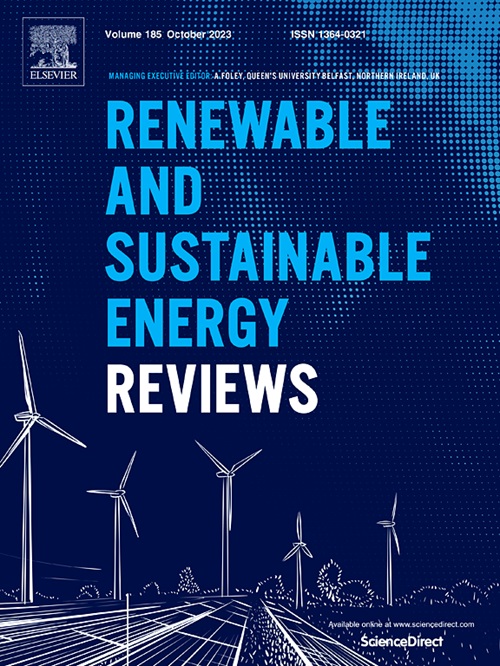Multiscale hybrid surface structure modifications for enhanced pool boiling heat transfer: State-of-the-art review
IF 16.3
1区 工程技术
Q1 ENERGY & FUELS
引用次数: 0
Abstract
With substantial heat dissipation capacity and high energy efficiency, pool boiling represents a promising thermal management solution for high-power-density computing technologies. To address the increasing demand for improved heat dissipation, pool boiling heat transfer must be enhanced to attain a lower initial boiling temperature, increased heat transfer coefficient, and improved critical heat flux. Modification of surface structures is effective to achieve these enhancements, and recent studies have focused on multiscale hybrid surface structure modifications for synergistic effects. Compared with single-scale surface structure modifications, multiscale hybrid strategies are more complex in terms of enhancement mechanisms, influencing factors, and numerical modeling. However, timely reviews that explore and summarize these achievements are still lacking. To bridge this gap, this study presents a state-of-the-art review on multiscale hybrid surface structure modifications aimed at enhancing pool boiling heat transfers. First, This research introduces three typical scaled surface structure modifications, including macroscale, microscale, and nanoscale strategies. Subsequently, their hybrid use, enhancement mechanisms, and major influencing factors are systematically explored, reviewed, and summarized. Specifically, this research focus on macro/micro hybrid structures, micro/micro hybrid structures, micro/nano hybrid structures, and nano-amphiphilic structures. For each hybrid structure, different formats and combinations are presented and analyzed. Furthermore, the associated numerical modeling techniques are summarized and comparatively analyzed. Lastly, the major findings are outlined, and recommendations for future studies are highlighted. This review can serve as a timely contribution to advancing our understanding of multiscale hybrid surface structure modifications for enhanced pool boiling and provide guidance for advanced surface structure modification techniques.
多尺度混合表面结构改造用于增强池沸腾传热:最新技术回顾
池沸腾具有强大的散热能力和较高的能效,是高功率密度计算技术中一种前景广阔的热管理解决方案。为了满足日益增长的改善散热的需求,池沸腾传热必须得到加强,以达到更低的初始沸腾温度、更高的传热系数和更好的临界热通量。表面结构改性是实现这些改进的有效方法,最近的研究侧重于多尺度混合表面结构改性,以获得协同效应。与单尺度表面结构改性相比,多尺度混合策略在增强机制、影响因素和数值建模方面更为复杂。然而,目前仍缺乏对这些成果进行探讨和总结的及时综述。为了弥补这一不足,本研究对旨在增强池沸腾传热的多尺度混合表面结构改性进行了最新综述。首先,本研究介绍了三种典型的尺度表面结构改性,包括宏观尺度、微观尺度和纳米尺度策略。随后,系统地探讨、回顾和总结了它们的混合使用、增强机制和主要影响因素。具体而言,本研究重点关注宏观/微观混合结构、微观/微观混合结构、微观/纳米混合结构和纳米亲水结构。针对每种混合结构,介绍并分析了不同的形式和组合。此外,还总结并比较分析了相关的数值建模技术。最后,概述了主要研究成果,并强调了对未来研究的建议。这篇综述有助于加深我们对多尺度混合表面结构修饰以增强池沸腾的理解,并为先进的表面结构修饰技术提供指导。
本文章由计算机程序翻译,如有差异,请以英文原文为准。
求助全文
约1分钟内获得全文
求助全文
来源期刊

Renewable and Sustainable Energy Reviews
工程技术-能源与燃料
CiteScore
31.20
自引率
5.70%
发文量
1055
审稿时长
62 days
期刊介绍:
The mission of Renewable and Sustainable Energy Reviews is to disseminate the most compelling and pertinent critical insights in renewable and sustainable energy, fostering collaboration among the research community, private sector, and policy and decision makers. The journal aims to exchange challenges, solutions, innovative concepts, and technologies, contributing to sustainable development, the transition to a low-carbon future, and the attainment of emissions targets outlined by the United Nations Framework Convention on Climate Change.
Renewable and Sustainable Energy Reviews publishes a diverse range of content, including review papers, original research, case studies, and analyses of new technologies, all featuring a substantial review component such as critique, comparison, or analysis. Introducing a distinctive paper type, Expert Insights, the journal presents commissioned mini-reviews authored by field leaders, addressing topics of significant interest. Case studies undergo consideration only if they showcase the work's applicability to other regions or contribute valuable insights to the broader field of renewable and sustainable energy. Notably, a bibliographic or literature review lacking critical analysis is deemed unsuitable for publication.
 求助内容:
求助内容: 应助结果提醒方式:
应助结果提醒方式:


